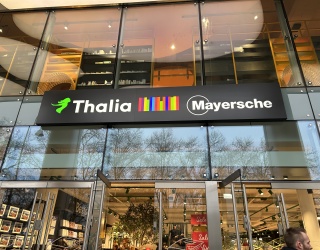
Caddie from Strasbourg, France, counts itself among the market leaders for transport solutions for retail, airports, the hotel industry, manufacturing and hospitals. The company, which is active in more than 100 countries introduced new shopping carts with removable canvas bags at the EuroShop and also showcased different plastic shopping carts. Are the days of the metal shopping carts soon numbered?
Caddie comes from France. What is different there compared to Germany when it comes to shopping carts?
Off the top of my head the fact comes to my mind that by comparison, in France we supply many shopping carts with scanner mounting brackets. This is due to the differently organized food trade. Over there, there are a lot more hypermarkets, which have relied on self-scanning for years. In France, shopping carts on average have a larger cradle size, are deeper and have more accessories such as dividing grills for bread, fruit and vegetables. The French on average shop less frequently – yet they shop in larger amounts.
Internationally, where do you see the strongest growth potential?
The largest and most expandable markets are in Eastern Europe and the booming countries like India and China. Due to a lack of presence, the U.S. market is still interesting to European shopping cart manufacturers. Especially Germany and the German-speaking areas count among the markets with the largest grown potential for Caddie. That’s why we specifically have been developing models for the German market for several years. For several models there was even investment in new, robot controlled assembly lines – needless to say from Germany!
How big should a shopping cart be?
To select the cradle size and shopping cart model based on size load seems outdated to me. Of course, the cart has to be large enough in regard to the product range. However, I think the ergonomics of the shopping cart and the ability to be incorporated in the relative concept is far more important. If freshness is essential, carts with multi-compartments or dividing grills make sense. In the non-food area a larger cradle size plays a crucial role. And for smaller purchases, like those made by singles or people 65 and older for instance, shopper carts are ideal. The choice of shopping cart should therefore always be seen in the overall context, which includes the range of products, target groups and last but not least also the location.
Outside many supermarkets and discounters are similar shopping carts, which only differ by the logo on the handle. How can modern caddies contribute to store branding?
The branding on the handle is certainly the biggest distinguishing feature at first sight. But you can also distinguish the carts by a new color, ergonomic and multifunctional handles, by RFID and last but not least by their immaculate condition and cleanliness. I think the latter is often underestimated.
Are the days of the metal shopping carts numbered?
The classic wire cart is part of retail and definitely also won’t be ousted in the next ten years. However – as I have already indicated – the ergonomics of the carts will change. And the number of different cart types per market will increase to be able to optimally serve the various target groups. Customer service and the introduction of International experience will become more and more important in this case. Plastic- or rather hybrid shopping carts are in vogue at the moment. The same phenomenon was around in the U.S. about ten years ago. Eventually retailers there thought the expenses for maintenance and cleaning were too high. What’s more, from an environmental point of view the wire cart is completely recyclable. Caddie continues to rely on the wire cart and develops it further, for example with new noise absorbing elements or new coatings.
What is the advantage of plastic? In which instances is metal superior?
Like with so many things, this is also at first a question of taste. Due to its design, the plastic cart clearly sets itself apart from the wire cart. The surface of the plastic cradle also appears more dimensional, which carries the color better and makes the cart more striking overall. Attention should be paid to the fact however that this type of surface requires a more intensive cleaning, since the larger surface area allows for more dirt. Those who therefore choose a plastic shopping cart, should allow for two to four cleaning treatments per year, depending on the weather conditions. As far as noise reduction is concerned, at this point we can supply wire carts that are quieter than plastic carts by using solid plastic forks and different dampers. Some of our customers only use such low-noise carts.
At the EuroShop you introduced a shopping cart with canvas bags. How does this system work?
After having had a significant part in the triumphant success of the shopping cart as it looks today, we asked ourselves what the shopping cart 2.0 might look like. A modular system that’s customer-friendly and maximizes economical and ecological benefits. What emerged was our new cart generation “Wind“. Wind is available in three different sizes to meet the demands of the different markets. Due to its special build, this model provides room for larger non-food items, small articles, bottle packs and so on. In addition. and if needed with the model Wind “L“, up to five plastic bottles can simply be hung via a patented system. This way, the customer can already presort the merchandise in the store: For example frozen items into an insulated bag, fruits and vegetables into another bag and so on. Since the bags belong to the customer, we don’t have a sanitation issue; the customer is in charge of their own. Compared to baskets, bags that can be closed can be better transported in public transportation or on bicycles. This gets more difficult with baskets.
At first Wind originated as an addition to shopping cart fleets. Depending on the concept, we advise our customers to replace 20 to 30 percent of their fleet with the new Wind. We will know more about customer reactions at the end of this year. We are anxious and excited…
Would retailers pay for this or the customers?
The end customer has the chance to purchase the bags. At the same time, this means for the retailer that he can recoup a part of the cost through the sale of the bags. Another approach is that customers receive the bags for free, for example within the scope of loyalty programs. All variations are possible.
Can customers also use the bags outside of the store for other purposes?
These are strong reusable bags, which naturally can also be used for other purposes. For instance you could think about special mounting brackets for the luggage trunk and you would simultaneously have a transport system for the car and consequently always have the bags handy. The Wind model “S“ consists of a base frame on 2 castors for just one bag – ideal for large cities and older target groups.
Self-scanning or displays on the cart: What is in demand and when will it be available all over the country?
Self-scanning has established itself a long time ago with our European neighbors. Germany is lagging behind the trend in this case. Particularly displays are the next big thing, this being the classics with advertising inlays. At the Euroshop we introduced a digital display prototype with Indoor-GPS. No doubt it will take a few years, until this one rolls through the store. In the medium term, I could imagine special applications for smartphones as feasible.
Do you see a readiness of the large chain stores in Germany to change the brand in terms of shopping carts?
Many desire a two-supplier strategy. For the customer this is primarily about the number distribution as a function of the individual size of suppliers. In Germany we supply customers like Praktiker, Aldi, Rewe Group, Norma and Edeka. In terms of classic shopping carts we are globally at number 2 – and thus more than an alternative solution.
What kind of trends to you foresee for the next few years?
The cart is getting more personalized. The shopping cart will become less noisy. We are pulling out all the stops in working on new solutions in this area. Sustainability will become a big topic, but also the individualization and recognition of retailers.
How is the demand for service in terms of cart maintenance coming along?
We are delighted that this area has once again become a stronger customer focus. The trend goes toward holistic fleet management. In an intelligent fleet management, peak times, this meaning times like Easter or Christmas could be supported through back-up fleets. Repairs and washing on-site become less important due to economic and ecological reasons. The customer wants to have clear and operational shopping cards at their disposal at all times – in the best case scenario in a completely transparent system. Thanks to RFID and independently developed software, we can identify each cart independent of the location. That is to say: Age, previous repairs and expenses, different stations. At any time, our customers have an overview of costs, access to statistics and are able to budget annual quantities very precisely through this system.
Interview by René Schellbach, iXtenso.com





